Design-specific mechanistic regulation of the sensing phenomena of two Schiff bases towards Al3+†
Abstract
We report herein two optical probes (R1 and R2) for the fluorogenic detection of Al3+ at the level of 10−8 M. R1 and R2 were synthesized by simple Schiff base condensation of 4-amino-3-hydroxy-1-naphthalene sulfonic acid with 5-bromosalicaldehyde and 2-hydroxy-1-naphthaldehyde, respectively. The same were characterized by various spectroscopic techniques. R1 and R2 both underwent fluorescence emission upon their respective interactions with Al3+ in an ethanol : water mixture (4 : 1, v/v). The binding modes of the receptors with Al3+ were studied through 1H NMR spectroscopy, Job plots, and HR-MS, as well as through binding constant determination involving fluorescence titration data. The quenching of –C![[double bond, length as m-dash]](https://www.rsc.org/images/entities/char_e001.gif) N isomerization and of photoinduced electron transfer (PET) seem to be responsible for the fluorogenic switch-on situation of R1 and R2 with Al3+. At the same time, excited state intramolecular proton transfer (ESIPT) also plays an important role in the ratiometric fluorescence response of R2, which is a consequence of a minor structural variation in R1 where the bromophenyl moiety is replaced with a naphthalene moiety. The mechanistic aspects of the sensing phenomenon are discussed in terms of 1H NMR titration as well as theoretical calculations at the density functional level.
N isomerization and of photoinduced electron transfer (PET) seem to be responsible for the fluorogenic switch-on situation of R1 and R2 with Al3+. At the same time, excited state intramolecular proton transfer (ESIPT) also plays an important role in the ratiometric fluorescence response of R2, which is a consequence of a minor structural variation in R1 where the bromophenyl moiety is replaced with a naphthalene moiety. The mechanistic aspects of the sensing phenomenon are discussed in terms of 1H NMR titration as well as theoretical calculations at the density functional level.


 Please wait while we load your content...
Please wait while we load your content...